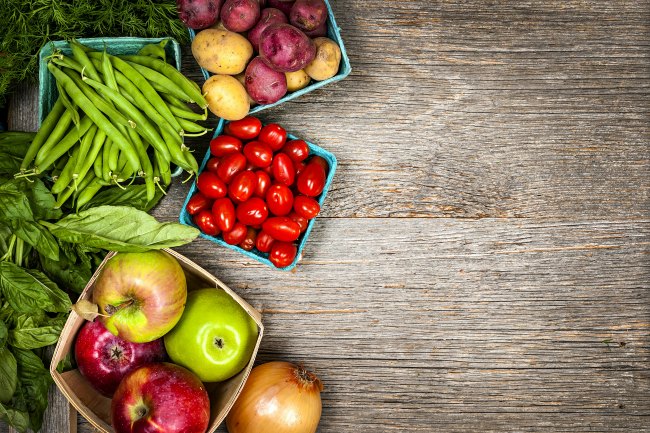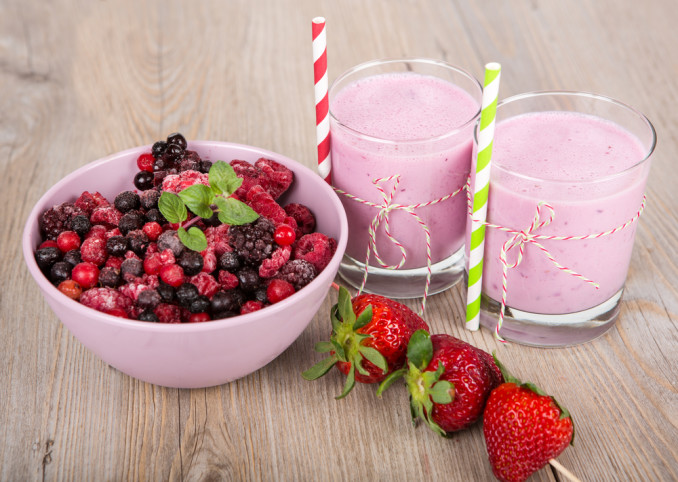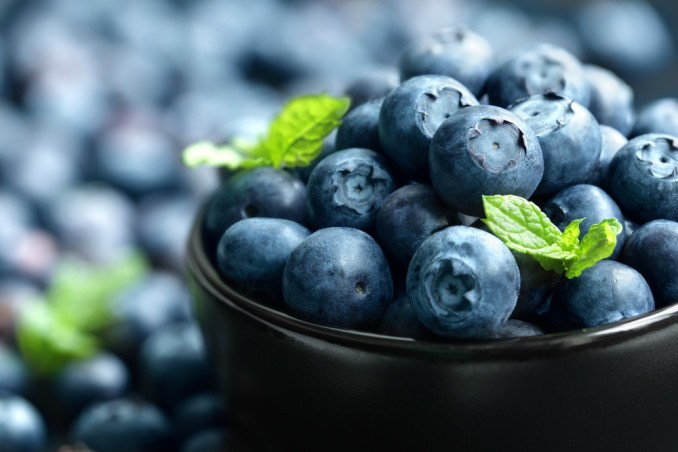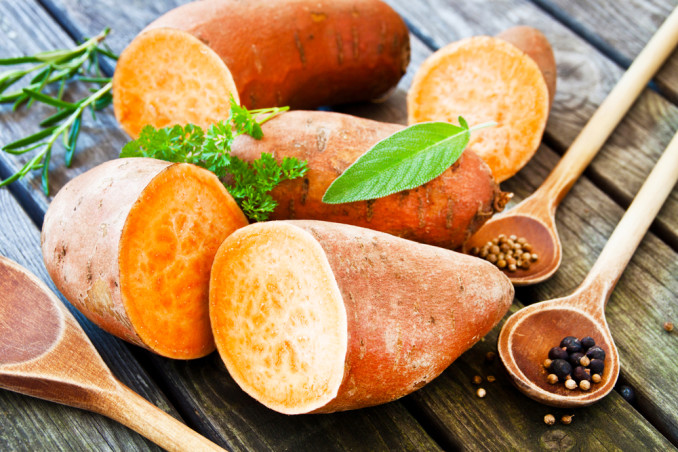
Sweat.
Persistence.
DOMs!
You were certain your six-pack would come back to play by New Year.
After all, you followed a strict workout and diet regime in the last 6 months.
The Judgement Day comes… You even wore your best set of clothes (or lack thereof).
As you eagerly lifted your shirt up and looked at the mirror… you had no idea why you look so bloated (uh… no the perfect six-pack is till hidden).
As you thought things couldn’t be any worse… you found out that you had breakouts (yes… too much whey)!
What?!
So your last 6 months of hard work just went down the drain?
No, not yet. Maybe with just a few tweaks in what you eat, you could improve your game and yes, get your six-pack back.
But, this improvement in your diet is not for the faint of heart. This requires commitment, discipline, and willingness to change the way you cook your food. But hey, this is what the New Year is for, right? Got New Year Resolutions?
Today, I’ve invited Katie Mae, a plant-based nutritionist and culinary instructor at the TrueNorth Health Center, and Dr. McDougall’s Health and Medical center, two leading locations for lifestyle medicine in the world, to share with us her teachings on the salt, sugar, and oil-free diet.
Seriously, I don’t think your diet can get much cleaner than this. What Katie teaches can certainly improve your game in nutrition, whether you want to go salt, sugar and oil free completely or not.
We’ll be talking about:
- How Katie transitioned from SAD (Standard American Diet, a worldwide phenomenon on industrial foods not just pertaining to America) to a raw vegan diet
- Why Katie went from raw vegan back to a vegan diet with cooked starches
- What Katie ate on a raw vegan vs. a “starchivore” diet (detailed menu for breakfast, lunch & dinner)
- How Katie gradually eliminated salt, sugar, and oil from her diet
- What going salt, sugar and oil-free really means
Stay tuned for the next part HERE!
Video Interview (Part 1):
Edited Transcript + Article:
From SAD to Raw Vegan
Q: Katie, why don’t you give us an introduction of your work?
Katie Mae: Sure. I’m a nutritionist and cooking instructor. I’ve been doing a plant-based diet for five years now, more specifically, a whole foods, plant-based diet. I’m absolutely loving it.
About three years ago, I added in the aspect of no oil, salt and sugar. So I could keep it really clean and really playful with lots of herbs and spices. It works so well for me.
I’m so passionate about my salt, sugar and oil-free diet that I want to share it with other people.
And there’s so much information out there about nutrition and everything, so I’m more interested in helping people actually do it in their own kitchen so they can apply everything they know about a plant-based diet in their own life.
Q: You went from a Standard American Diet to 100% raw vegan. Tell me more about that. How did going raw vegan make you feel at that time?
Katie Mae: It was amazing. I forced myself to do a vegetarian diet just because I didn’t know anything about lentils and beans. Lots of the vegetables were brand new to me coming off of a standard American diet.
That year I was vegetarian, I actually saw the movie Reversing Diabetes in 30 Days, with Gabriel Cousens at the Tree of Life in Arizona so I knew that I had to do raw and I thought that was the healthiest thing ever.
I started to slowly increase my intake of raw foods. I started a raw food bar at the Whole Foods Market near me. That was really powerful. It was really successful.
After a couple of months of trying to do it on my own, I thought it’d be so much more helpful to have a community. So I actually left Whole Foods to work at a raw food restaurant, and I started dating someone that was interested in the raw food diet as well.
So that January of 2011 I believe, we went 100% raw vegan. It was amazing, because I wasn’t having any of the dairy. I wasn’t having any of the processed food in general. It was just a world of difference.
My digestion improved. My skin was vibrant. It wasn’t clear 100%. I had a lot of acne growing up, but when I went raw, my skin had so much more color.
I had a tan! I was living in Washington State, North US. Even though there wasn’t much sun around, I looked like I had a tan because I was eating so many vegetables.
My energy and my immune system were better. I wasn’t getting sick during the winter like I used to. So it was a really, really a great move and I actually went to volunteer at the Tree of Life in Arizona. For a couple of weeks, I worked in the garden and that was really awesome to see everyone living 100% raw.
From Raw Vegan to Starchivore?

Q: Then you went from being raw vegan back to incorporating some cooked grains and foods in your diet. Why is that?
Katie Mae: That was for a couple of reasons. First, the main reason I went raw to begin with is because I thought it was the only solution to reverse disease. So obviously if a raw vegan diet was reversing disease, including diabetes, then it was a very healthy diet.
Secondly, I hadn’t known of any other diets that were able to reverse a chronic condition like that.
However, I came across Dr. McDougall’s work, and I realized that he was teaching a plant-based diet, though it was more focused on starches, cooked starches. Dr. McDougall was also reversing diabetes, among many other conditions. As a result, I realized that it didn’t have to be as extreme for people to get the benefits.
I also found incorporating cooked foods in my diet much more sustainable. In the past, I was dating someone who was also a raw foodist, and worked in a raw food restaurant. As a result, being a raw foodist was sustainable for me at that time.
However, it was very difficult to enjoy meals with my family without having to make my own specific meals.
So the main reason why I started incorporating cooked foods in my diet was that I believe this is more sustainable than following a 100% raw food diet.
I did feel a little bit better having cooked starches. I felt like I had even more energy and my skin cleared up even more because when I was doing a raw food diet, I haven’t heard of the 80/10/10 Diet, where carbohydrates accounted for 80% of the calories.
Instead, I was doing this raw food diet based on Gabriel Cousens’s recommendations, which was a lot of fat and so that high fat content actually slowed down my digestion as well.
When I started eating a carbohydrate-based diet, it just got so much better. My skin cleared up even more, and my energy felt better. It felt more sustainable.
And there’s a comfort aspect of it. You know emotionally, I liked the warm food. So a mix of the raw and cooked worked best for me.
Too Much Oil in the Raw Vegan Diet?
Q: When you talked about the amount of fat in your diet, how much fat did you consume as a percentage of total calories as a raw vegan on average?
Katie Mae: I would guess it was between 30% and 40%. I’m not sure of the exact amount, but my breakfast was cabbage, apples and almond butter. Cabbage and apples have very little calories, so I must have been having a lot of almond butter.
I was buying whole almond butter jars every few days and all my salad dressings were based on tamari and nuts and oil sometimes.
I kind of knew that I didn’t want the oil as much as the nuts. So I was starting to reduce the oil.
But we were having a lot of olives and a lot of avocado, a lot of chocolate and coconut. We weren’t really limiting the desserts. So the desserts were full of agave and coconut oil, nuts and fresh coconut.
What I ate on a raw food diet was very caloric dense; very low calories on one end and then very high calories on the other end. There weren’t really the starchy in-between foods.
Starches are 500 to 600 calories per pound; vegetables are 100 calories per pound; nuts and seeds are 2,500 per pound; while oil is 4,000 calories per pound. So I was getting the vegetables on one end and the fats on the other end, and nothing in-between.
Q: Before we continue with the SOS diet, why don’t you tell us about the breakdown of breakfast, lunch and dinner in your raw vegan diet versus your current diet, which includes starches and cooked grains?

Katie Mae: There’s a lot of variation between the raw community and the plant-based communities so I cannot speak for all.
However, here’s the breakdown.
Day-In-Life: What Katie ate on her raw, vegan diet
Breakfast:
When I was doing raw, my breakfast, like I said, included almond butter with cabbage and apples.
Lunch:
I would have a really big salad, with some sort of fatty dressing. So the salad would often be based on cabbage. I really liked cabbage, shredded with lots of vegetables shredded up and then nuts. I had a lot of Asian seasonings like tamari, ginger, curry, cumin.
I wasn’t a big fan of making burgers and dehydrating everything, so it was generally just a salad and then I would have more fruit throughout the day.
Dinner:
I usually have another salad and often a soup, a blended soup that had may have some carrots, bell pepper and avocado. I loved those soups. I would just blend it all in a Vitamix and you wouldn’t heat it.
The Vitamix would just do a little bit of heating, so it was more like room temperature than being cold like a smoothie. So those were my raw food meals.
Then when I went to a starch-based diet, the below is a sample meal plan:
Day-In-Life: What Katie ate on her starch-based diet:
Breakfast:
Initially what I did for two or three years was oatmeal and fruit every morning. I had a bowl of oatmeal and fresh fruit, often nuts, mainly seeds or added flax seeds. Sometimes a little bit of nuts or pumpkin seeds. But lots of fresh fruit.
I live in California now, so there is always seasonal fruit. So that’s what I really went towards and because I was having the seasonal fruit it never got boring. I looked forward to breakfast so much, that’s what got me out of bed in the morning.

Lunch:
I would have sweet potato tacos with corn tortillas. I wasn’t doing any oil when I started the starch-based diet. I cut out the oil.
So these tacos were oil-free, 100% corn, organic corn, and any sort of potato or squash, some sort of starch, sometimes rice, beans and lettuce, tomatoes or spinach and kale collards and guacamole or I got just fresh avocado. That was either for lunch or dinner.

Dinner:
Dinner would be a warm soup, like a lentil or bean soup.
When I first added in the starches, I was still having the salads like I used to have on a regular basis and then they weaned out, because it was more comforting to have the warm food. So this year, I’ve actually incorporated more of my vegetables back in.
Q: Just to clarify, in the previous raw diet you followed, you ate a lot of greens, as well as quite a lot of fat from avocado, nuts, and oil?
Katie Mae: Right.
Q: Anything else?
Katie Mae: Well, I was having a lot of dessert, which contained a lot of oil. I mean not throughout the day, but almost on a daily basis. We would have a dessert after dinner and in the desserts there were a lot of coconut, avocado, and cashews.
I wasn’t using oil in my own cooking that much. It just never really appealed to me, especially when I was doing raw.
However, there’s a lot of oil in raw dishes when I was eating out. For instance, I worked at a raw food restaurant. They’d have raw cheese cakes and raw apple pie, and there was a lot of oil in those foods.
Even salads like the kelp salad contain lots of fat like sesame and olive oil. There was definitely a lot of fat.
From a Starch-Based Diet to a SOS-Free Diet
Q: From a starch-based diet, you transitioned into the SOS-free diet. What does SOS-free mean?
Katie Mae: SOS-free means Sugar, Oil and Salt free. I came across this through Dr. Alan Goldhamer, Founder of the TrueNorth Health Center, and the concept is around pleasure-trap. We get addicted to these foods because they’re so high in calories and it’s very little nutrients in them.
Our body wants to conserve as much energy as possible and get the most amount of pleasure. When we have foods that are high in sugar, fat and salt, we get a ton of immediate pleasure from it, without having to do much at all. Some people are more addicted to these foods than others.
On the scale of susceptibility to having the addictive pulls to these foods, I’m very high. I’m at like a 10 plus. So I really resonated with eliminating them, because I can’t… I think it’s kind of a myth to say that we can do something in moderation.
Very few people can have just a little bit and not be pulled back into having more and more. So, for me it was best to eliminate them altogether.
Then, knowing the science behind it, the clinical evidence and all of the scientific research behind these foods and what they can do to our bodies just made it so clear to me that there was no other way. I had to adopt the SOS-free diet.
I’m not perfect by any means, but I keep my house free of salt, oil, and sugar, and I teach other people how to cook this way.
I don’t expect anyone to be perfect, but by teaching how you can sauté vegetables without any oil or how you can make a dish really flavorful without using any salt at all, allows people to reduce the amount of such ingredients in their diet. That’s the SOS-free aspect.
Q: From your experience with the clients that you’ve worked with, how has this diet helped people who are recovering from terminal illness or other diseases?
Katie Mae: The plant-based diet is really helpful because it eliminates the meats and the dairy. And dairy is probably the biggest issue with people being sensitive to it.
But then the sugar, oil and salt just take our health to another level when you can eliminate those things, because sugar and oil are inflammatory. And now we actually know that even the salt is inflammatory, when you have excessive salt in your body that is.
We probably need about 500 to 600 milligrams of salt everyday and we can get all of that through the food.
The SOS-free diet can potentially help the following conditions, in my experience.
Autoimmune Conditions
But when you have an excess of salt, it actually triggers the lymphocytes in your body so you’re creating inflammation. That’s really makes a difference for people that have autoimmune conditions when they’re trying to reduce their symptoms they don’t want to be having the salts or the oil and sugar.
So for autoimmune conditions, it makes a huge difference when people can reduce, or even better, eliminate sugar, oil and salt.
Type II Diabetes
Then for type II diabetes, when you eliminate the sugar and oil, that makes a huge difference. Obviously, the sugar is something that people reduce because of the high blood sugar, but that’s really just a symptom.
Type II diabetes is caused by an excess of fat in the diet. That’s one of the main reasons. One of the key pieces to doing a low fat diet is that we’re reducing people’s susceptibility to type II diabetes.
Hypertension and Heart Disease
Then you have hypertension and heart disease. Those are affected by the blood pressure and the amount of blood in your system, which is affected by how much salt, sugar, and oil we’re ingesting.
The oil we ingest from food can make us less energized, with a foggy concentration.
And that salt it makes you hold water, so you get this puffy look in your face and in your hands. Your rings don’t fit as easily.
But it also holds water in your artery walls. The arteries retain extra water when they have salt in them. Then that makes them less elastic. So they don’t dilate as easily so that just promotes more of the hardening of the arteries.
What does going SOS-free really mean?
Q: What about fruit, sugar, nuts and natural salt like Himalayan salt?
Katie Mae: The fruit is definitely healthy. There’s still many of the phytonutrients and the fiber in the fruit that regardless of the sugar it’s very healthy.
Q: So we should *not* confuse natural fruit sugar with the sugar that you were talking about (i.e. high fructose corn syrup and other refined sugars)?
Katie Mae: Right. Exactly and Dr. Michael Greger just came out with a video showing that even when we have fruit juice which fiber was removed, fruit juice is a more stable sugar in our blood than processed sugar, candy or dessert, because of the phytonutrients.
The phytonutrients cause the sugar to be digested slower. It’s a little bit about the fiber, but not solely.
The same applies to the nuts and seeds.
You get a lot of the nutrients, the phytonutrients, the iron and zinc and calcium, all these other things that our body needs when you’re consuming the whole nuts or the whole seed rather than just the oil, which is 100% fat, with very little nutrition added.
Q: So definitely no coconut oil and olive oil.
Katie Mae: Right, right.
Q: What about Himalayan salt?
Katie Mae: Himalayan salt has a little bit of nutrients. It definitely does. But when you compare the nutrients in Himalayan salt, it’s very, very insignificant compared to the fruits and vegetables that we’re eating.
For example 1 tsp of Himalayan salt has 2,000mg of sodium, but it also has 12 mgs of calcium. In order to get just 10% of the RDA for calcium from the salt, we would need to consume an amount that also gave us over 16,000 mgs of sodium! An much better source of calcium would be leafy greens. For instance can meet 20% of the RDA for calcium with just 1/2 cup of cooked collard greens.
If you want to the salt to contribute in a significant way to your nutrient consumption, it would involve consuming unreasonably high levels of sodium. Thus, salt is not something we should consume for nutrients.
I recommend that people use salt as a condiment at the table, rather than cooking with it in the kitchen.
With salt sprinkled on top of our food, our tastebuds can detect it much easier, which means we need less for the same enjoyment.
If you wanted to actually make a significant dent in your nutrient intake by having Himalayan salt, you would be having so much that, I mean you’d be puffed up you couldn’t even consume the amount you needed to get those nutrients.
So it’s not something we should be having for nutrition. Then when it comes to the sodium, it’s really not any lower in sodium, so it still has a negative effect on our body.
This is the end of Part 1.
In the next parts, we’ll be discussing:
- Is gluten bad for you? Do we need to go gluten-free?
- How to cook your vegetables deliciously, without oil, sugar and salt
- How to eat out healthily so you can socialize, have fun and keep your waistline trim
- Strategies you can take to gradually transition into a salt, sugar and oil-free diet
Stay tuned HERE!
About Katie Mae: Katie is a plant-based nutritionist and culinary instructor at the TrueNorth Health Center, and Dr. McDougall’s Health and Medical center, two leading locations for lifestyle medicine in the world. You can visit her website here.
Source: Thinkstock / Elena Elisseeva ; Fotolia / uckyo

